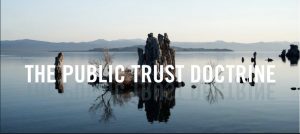The legal doctrine has ancient origins, from the Roman Empire through the English Magna Carta and common law, and applies to the ownership and management of certain natural resources, including water, shorelines and air. It holds generally that these resources are owned by the public for the use of all people. It further holds that the legal doctrine can be invoked to protect these natural resources against abuse by individuals or companies or other entities. For example, no one can usurp the waters of a navigable stream for their own use to the exclusion or detriment of others who do or want to use the same waters. At the same time, governments have no right to attempt to transfer ownership or control over public resources to others for private gain.
The doctrine was given prominent attention in the United States by an article by Joseph L. Sax in 1970 which argued that the doctrine had wide application in protecting natural resources and for expanding environmental law, which was then just beginning to be developed. It has also been adopted by numerous countries for the same purpose.

From time to time, the doctrine has surfaced to expand environmental rights. Most recently a number of lawsuits have been filed in the US, and elsewhere, on behalf of young people claiming that the public trust doctrine provides a legal basis for holding governments responsible for failing to protect the earth, and its natural resources, against the damages from climate change, and requiring the governments to do more to reduce the risks from climate change. In another possible application, it has been argued that the doctrine may well be useful in the UK after Brexit to provide protections that will no longer be available from the European Union and its Court of Justice.
Some further ideas to explore on Public Trust Doctrine
Identify any case in the past 50 years that has applied the Public Trust Doctrine to a problem affecting natural resources in the Republic of Ireland, Northern Ireland or the United Kingdom.
Identify an activity or project that is threatening to harm or destroy a natural resource in your area and determine whether the Public Trust Doctrine could be used to protect the natural resource.
Are the minerals under public land or the seas owned by the public, like groundwater, and subject to the Public Trust Doctrine? Does the Doctrine apply to fracking for oil or gas?
Sources
Michael C. Blumm and Rachel D. Guthrie, “Internationalizing the Public Trust Doctrine: Natural Law and Constitutional and Statutory Approaches to Fulfilling the Saxion Vision,” University of California, Davis Law Review (Vol. 45:741, 2012). lawreview.law.ucdavis.edu/issues/45/3/topic/45-3_blumm.pdf
Christopher Solomon, “The Newest Legal Tool to Fight Climate Change Is as Old as Ancient Rome,” Outside (27 May 2016).
The Newest Legal Tool to Fight Climate Change Is as Old as Ancient Rome
Marc Willers and Emily Shirley, “The public trust doctrine’s role in post-Brexit Britain,” Garden Court Chambers (31 March 2017). www.gardencourtchambers.co.uk/the-public-trust-doctrines-role-in-post-brexit-britain/
No comments yet, add your own below